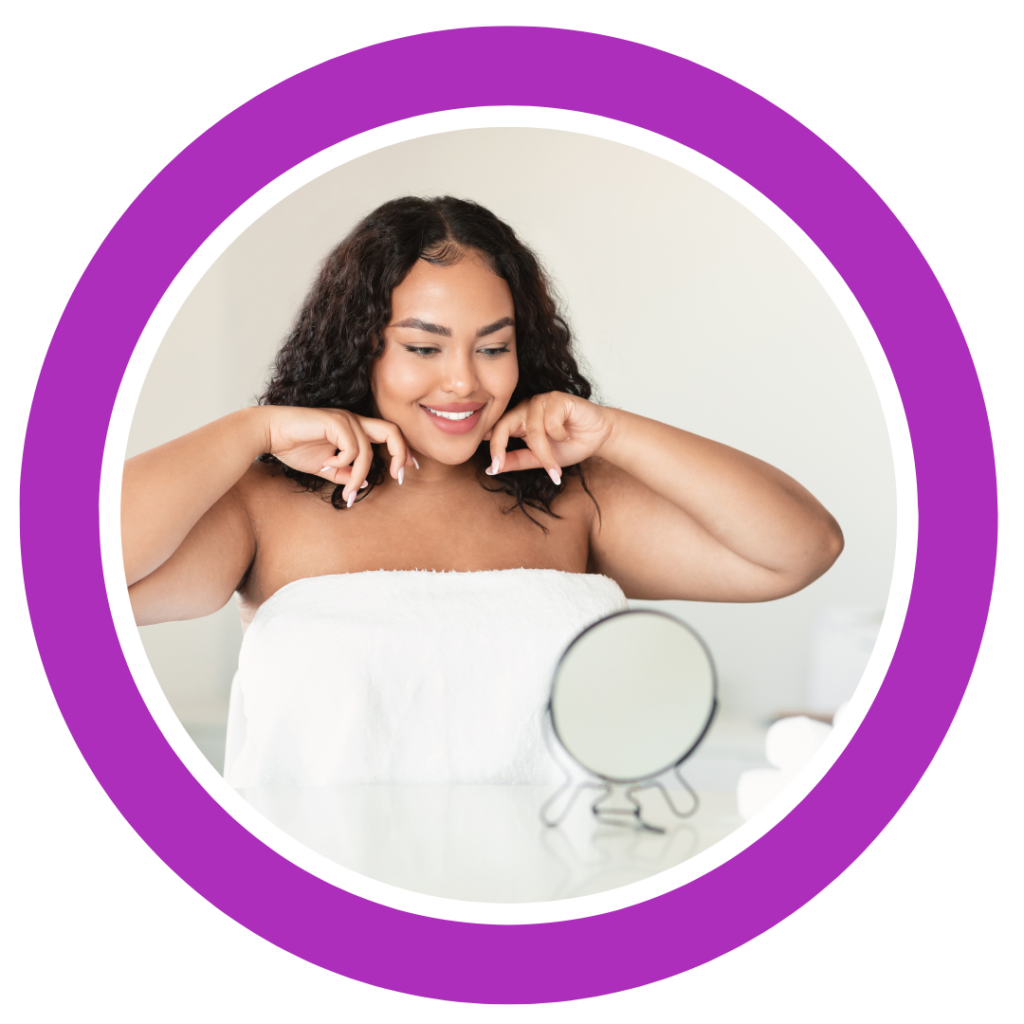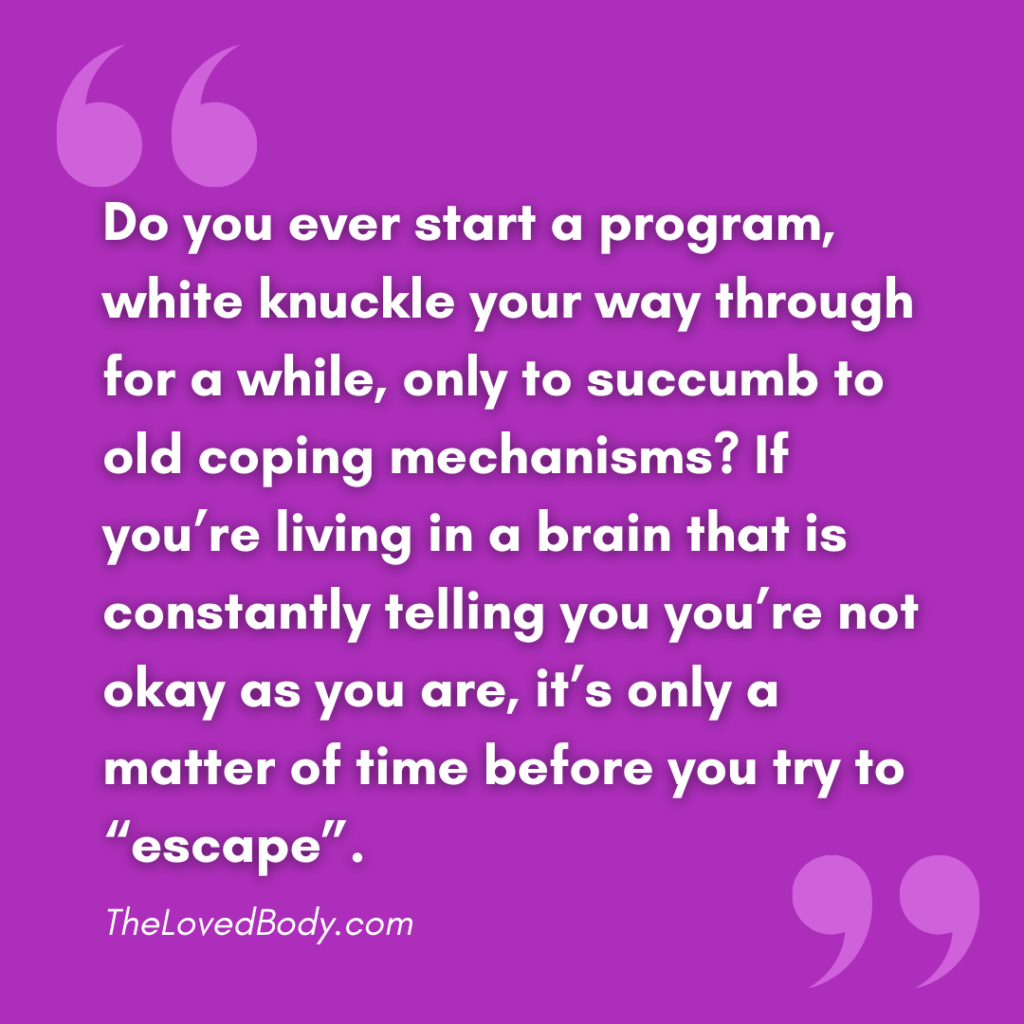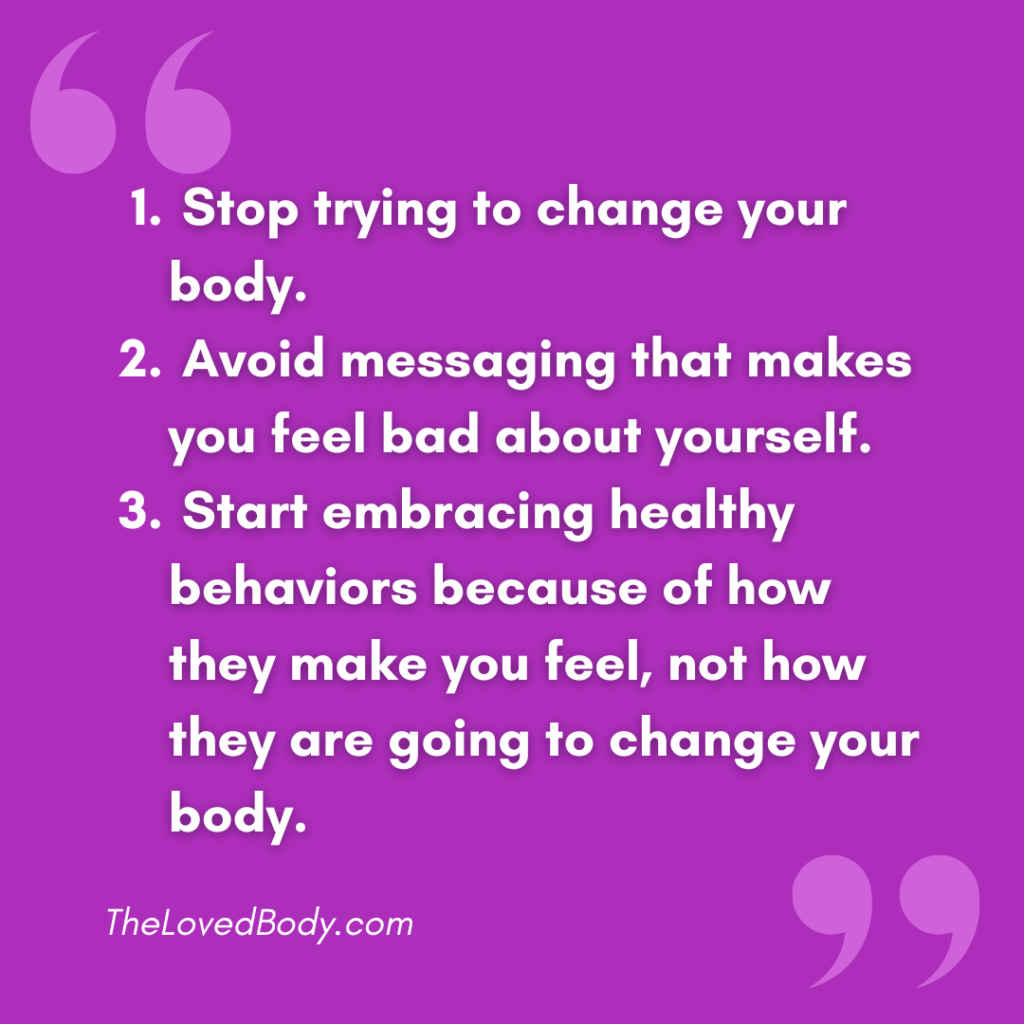The Miracle of Positive Self Image and Self-Talk
Last week we talked about creating space to change our habits. This week let’s build on that and create space to improve our self image and self-talk.

Take a moment to think about what your recent self-talk has been about your body.
Some examples might include:
- “I wish I had smaller shoulders.”
- “Ugh, I look bloated or puffy today.”
- “Have I lost muscle? Does my booty look deflated?”
- “I wish I looked more like (fill in the blank).”
- “Is this (fill in the blank body part) getting saggy?”
What’s the common theme of all these statements?
If you said self criticism, you are correct. Nothing of beauty ever came out of hating it. And nothing will drive you to unhealthy coping mechanisms like creating a hostile environment in your own head.

As much as many of us have been taught to embrace shame as a means to change our perceived flaws, the reality is that shame drives us away from what we truly desire: contentment. Most of us are looking for peace, contentment with ourselves, and acceptance. Our culture, our caregivers growing up, and our life experiences define what we believe will provide those things. Over time, we believe we will find contentment, acceptance, and peace with our body if we can force it into a mold of what we believe encapsulates those values. So we embark on a journey to search for solutions to the problem that is us. Enter the billion dollar beauty and fitness industry, that will provide you with all kinds of programs, supplements, and quick fixes to solve the problem that is your body. When you find THE solution, you will finally find the contentment, peace, and acceptance you’ve been looking for.
As the famous quote from the Wizard of Oz goes, “You’ve always had the power, my dear, you just had to learn it for yourself”. We can find contentment, peace, and acceptance right now without having to fix a single thing.
Why is self-talk important?
This is such a critical practice because we are driven much more towards things that make us feel good, than we are repelled by things that make us feel bad. In other words, you will continue behaviors that make you feel good about yourself much more easily than behaviors that make you feel bad about yourself. For example, if you focus on all the things you enjoy about exercise you are much more likely to desire exercise; I enjoy the time outside, I enjoy listening to music while I walk, I enjoy the way I feel after, etc. As opposed to focusing on what you don’t like, which will create a negative association in your brain with the activity; I hate sweating, it’s too much time, I don’t want to have to exercise, you have to do this to lose weight, etc. The brain is making associations with everything we experience. If our brain is creating negative associations with the very health behaviors we’re trying to adopt, we will always run into resistance to doing them.

Another more insidious way this plays out, is the underlying messaging we receive from trying fix our bodies: you are flawed. If we only exercise to fix our bodies, exercise is associated with feeling bad about ourselves. If we only eat healthy, to change our body, healthy food is associated with feeling bad about ourselves. If we only practice stress management when we’re trying to control our cravings, those behaviors that are supposed to calm us are now associated with fixing ourselves. When we feel bad about ourselves we can only push through those behaviors so long. Do you ever start a program, white knuckle your way through for a while, only to succumb to old coping mechanisms? If you’re living in a brain that is constantly telling you you’re not okay as you are, it’s only a matter of time before you try to “escape”.
Take a moment and think about a situation where you are talking to another person and that person is harshly criticizing you. (Think of all the negative ways you talk to yourself) What would you do? Would you stay around that person? Would you want to spend time with them or would you create space? Most of us would leave and stay away from that person. We have the same response to our own self talk, except we can’t just leave. Or can we? Food, alcohol, drugs, shopping, gambling, overworking, sex are all ways that we leave ourselves. Creating a safe headspace is how you stop leaving yourself. It’s also how you can find peace, contentment, and acceptance right now.
How do we start changing our self image?

Step one is stop trying to change your body!
You are perfect exactly as you are. You are not a problem to fix. Every time you catch yourself in the mirror focusing on what you don’t like, comparing yourself to someone else, or criticizing yourself try the following:
Take a breath.
Replace the thought with something else. It can be neutral or positive. It should feel true to you. Have it be short and ready to go; it can be hard to think of positive things when you’re in a bad headspace.
- I am fine as I am.
- I am (something you like about yourself).
- I am worthy as I am.
- I am here now.
Step two is avoid messaging that makes you feel bad about yourself.
Start paying attention to the accounts you follow on social media, the shows/movies you watch, the friends you spend time with. How do they make you feel? If you notice you feel bad about yourself after, that’s a sign there may be some messaging that is encouraging you to feel bad as you are. For example, you follow an account that has a lot of before and after pictures and you start to compare yourself or feeling like they have the answer; you have dinner with friends that talk about being bad for eating or needing to workout the next day to make up for the food they’re eating. While you’re trying to change your own beliefs, create space from those that would reinforce the negative.
Step three is to start embracing healthy behaviors because of how they make you feel, not how they are going to change your body.
There is no better affirmation than taking the time and effort to care for yourself. It sends a constant message that you are worth the time and effort it takes to put yourself first and care for your basic needs: sleep, movement, water, healthy food, and joy. When you practice these behaviors, look for what you enjoy about them and how they make you feel. Tell yourself you deserve the time it’s taking. Reflect on how you feel after and affirm any positive benefits. Lastly, if you catch yourself falling back into self talk about why you should or shouldn’t be doing things, practice the above self talk exercise:
Take a breath.
Replace the thought:
- “I deserve to have this healthy food and the time it takes to make it.”
- “I am worthy of the time it takes to exercise.”
- “I enjoy the time I have to myself to listen to a podcast while walking.”
We don’t have to spend our lives trying to fix the problem that is us. You are worthy just as you are, in this moment, with all your “flaws”, without having to fix anything. Your body is the vessel you get to experience this life in. Enjoy it!

